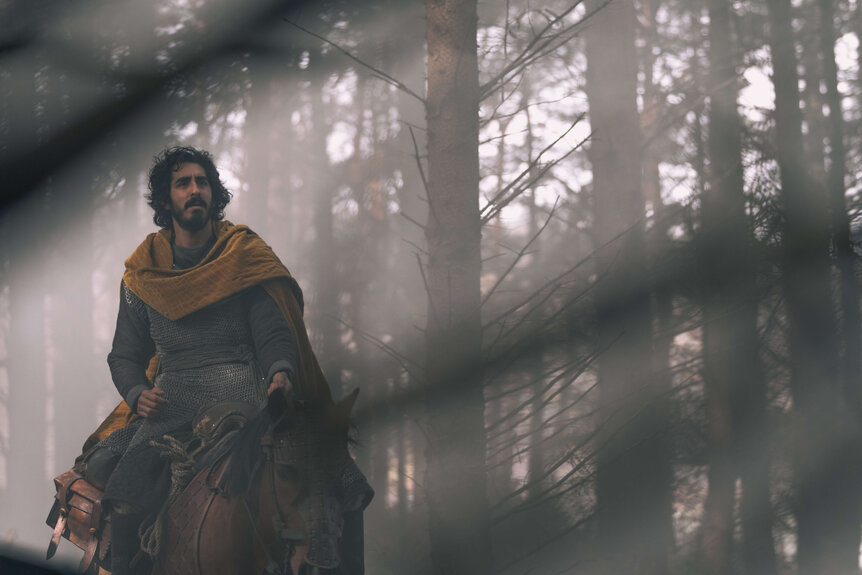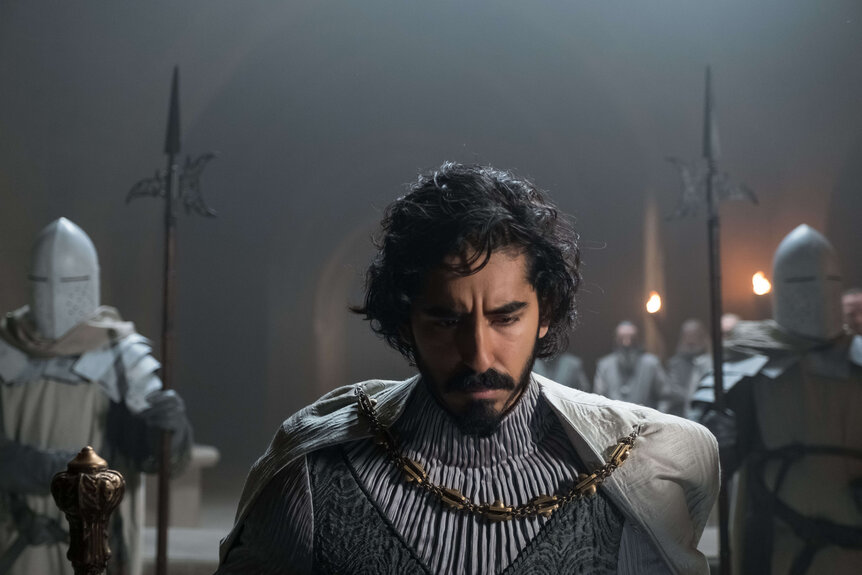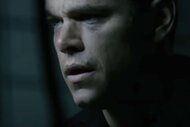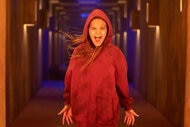Create a free profile to get unlimited access to exclusive videos, sweepstakes, and more!
The Green Knight embraces the weirdness at the heart of the Arthurian myth
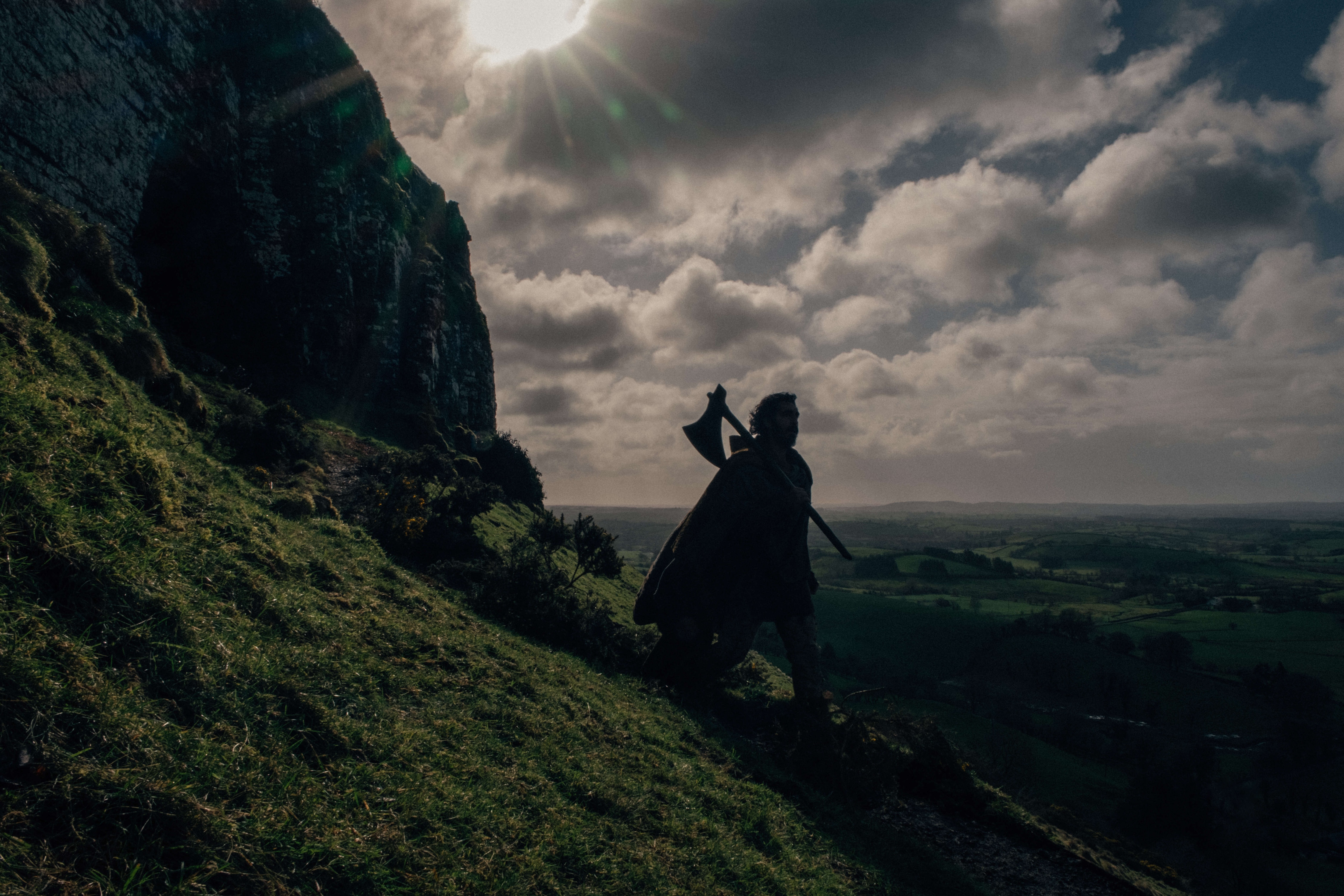
The legend of King Arthur and his Knights of the Round Table has lasted for hundreds of years because its many stories speak to universal truths of humanity — love, honor, brotherhood, and betrayal, often with a heaping dose of magic thrown on top. Yet, to look at modern pop culture, it’s still incredibly rare to see an adaptation of this legend that doesn’t somehow revolve around the love triangle between Arthur, Guinevere, and Lancelot. (Though to be fair, every so often we get to see the sword pulled from the stone first.)
This is a big part of the reason that David Lowery’s film The Green Knight — now in theaters and streaming for one night only on Aug. 18 — feels like such a revelation. Based on the 14th-century alliterative verse poem Sir Gawain and the Green Knight, it’s a story in which the famous king plays very little part. Instead, the film focuses on one of the Arthur myth’s secondary figures, a knight named Gawain whose original position as the king’s right hand was generally usurped by Lancelot in the later French romances. (And in pop culture itself.) As a result, though most modern audiences probably recognize the name Gawain, they likely view him as little more than an Arthurian bit player, a footnote in the adventures of other, more recognizable men.
Yet, the original medieval poem remains one of the most enduring tales from the time period, its multi-layered meaning having enticed all manner of academics, artists, and intellectuals to try and decipher the meaning in Gawain’s journey to the Green Chapel over the many years since its single surviving manuscript was discovered. (J.R.R. Tolkien’s translation is one of the most famous, but it is hardly alone.)
It features none of the most notable hallmarks of the Arthur myth — there’s no Excalibur, no Merlin, no Holy Grail, and no messy love triangle. Instead, it simply follows the knight Gawain on a hero’s journey to honor a vow made during a Christmas game, in which a strangely green human man on a green horse challenges him to an exchange of blows. There are allusions to many bizarre adventures during Gawain’s journey to fulfill his promise to meet the Green Knight again — which repeatedly test his honor, integrity, bravery, and even chastity — before allowing him to both face and be humbled by his own fears.
A chaotic mix of humor and horror, Sir Gawain and the Green Knight is a surreal, dreamlike story that embraces the contradictions within its own narrative and explores a very modern tension between sin, regret, and redemption.
So, too, does Lowrey’s screen adaptation. Unlike most of the other Arthurian blockbusters that have come through your local multiplex in recent years, like King Arthur: Legend of the Sword or The Last Legion, The Green Knight is not a terribly action-oriented film. Instead, it leans into the weirdness at the heart of the original tale without flinching, using its strange, alien, and often baffling imagery to tell the most human of stories. (There’s a reason that the film’s title can refer to more than one being within it.) This is a movie that doesn’t spoon-feed anything to its viewers, from simple facts like the basic identities of characters onscreen to larger questions of narrative meaning — such as how we’re meant to interpret the final moments of its story.
Warning: There are spoilers for The Green Knight beyond this point.
In The Green Knight’s world, Gawain is not yet the hero of legend or the flower of chivalry he represents in the original poem. Instead, Lowrey reimagines him as something of a medieval slacker, a wayward wannabe knight who has yet to accomplish any great deeds. So, when the strange tree-like Green Knight arrives in Arthur’s court on Christmas Day to challenge one knight to strike him with a sword and bear the same blow in return in a year’s time, Gawain eagerly accepts, beheading the stranger with a single stroke. “One year hence,” the apparently immortal Green Knight reminds him, laughing as he reclaims his own head from the ground, and the real part of our story begins.
The bulk of the film revolves around Gawain’s five-day journey from Camelot to the Green Chapel, a coming-of-age road trip that takes him through mysterious forests and gore-strewn battlefields, where a talking severed head is one of the least bizarre things he’ll encounter. The Green Knight fully embraces the strange magical realism that infuses many of the oldest Arthurian legends, presenting fully fantastical and wondrous things with little comment on how or why they exist. The film makes no attempt to explain the naked giants who wander Arthur’s lands or confirm whether ghosts are real, nor does it give a name to the obvious magic being worked by Morgan Le Fay, even as the world of Camelot is explicitly depicted as Christian. The Green Knight himself remains a mystery throughout, a green symbol that can be interpreted as a stand-in for everything from nature to death itself.
In many ways, Lowery’s movie often chooses to be even more opaque and strange than the work it is based on, expanding on encounters that merit little more than brief mentions in the original text, muddying the waters of other revelations, and inventing some characters out of whole cloth. The inclusion of figures such as the nameless scavenger who robs Gawain on the road and the ghostly Winifred who seeks her lost head are deliberate choices that represent larger thematic dualities. The Scavenger reflects the dark side of Arthur’s Camelot, an idyllic kingdom whose prosperity can only have been achieved through the slaughter of thousands. Winifred is a version of the 7th-Century Welsh saint of the same name, who was decapitated by a suitor enraged by her decision to become a nun. The spring that is said to have sprung up where her head fell is likely meant to be the same one Gawain dives into searching for it, and her fate stands as a cautionary tale about the dark side of even supposedly chivalric men.
Such frequently conflicting imagery reflects the tension that many of the original tales were caught in — a mix of traditional folklore and religious allegory that straddles two worlds, much as the bizarre Christmas game that kicks off our story reflects both Christian symbolism and pagan magic. The Green Knight also delights in showing its audience multiple versions of the story they’re watching play out onscreen, hints of worlds where Gawain dies of exposure after being tied up in the forest or becomes a miserable and unhappy king after abandoning his Christmas promise.
In the original poem, the Green Knight and the strange Lord of the castle that Gawain visits are revealed to be one and the same person, a man named Sir Bertilak de Hautdesert, who was given his double identity by Morgan Le Fay as a test for Arthur and the men of his court. Here, that is not the case, and the Green Knight clearly stands for something larger and much more nebulous — the never-ending tension between the old world and the new, as well as the natural world it’s built on top of.
Gawain’s fate is also clear at the end of the original story; in this film adaptation, it is largely left up to the viewer’s interpretation whether he lives or dies. The Green Knight embraces the ambiguity of that moment, giving us an ending where Gawain is both headless and whole, and where either of those things can count as a happy conclusion to his story, depending on your point of view. As a cinematic decision, it’s admittedly a bit of a strange one. But it’s hard to think of a more perfect resolution to this determinedly weird tale than one that boldly declares that maybe there’s no such thing as an ending at all.
The Green Knight is now and theaters and will be streaming via A24 on Aug. 18.
